When choosing a statement rug, measure your space accurately to pick the right size that complements your room without overwhelming it. Place the rug so furniture pieces sit comfortably on or around it, leaving a few inches of floor visible for balance. In living rooms, ensure the rug anchors the seating, while in bedrooms, extend it beyond the bed edges. Proper placement creates harmony and highlights your decor—if you keep exploring, you’ll discover more expert tips.
Key Takeaways
- Choose rug sizes that balance the space, leaving a few inches of flooring visible around the edges for cohesion.
- Measure your room accurately to select a rug that fits well without overwhelming or underwhelming the area.
- In living rooms, anchor furniture with rugs that extend beyond all pieces or just under the front legs for a unified look.
- For dining areas, ensure the rug is large enough to keep chairs on when pulled out, with at least 24 inches of extra space.
- Layer and overlap rugs thoughtfully, balancing size, pattern, and texture to create depth and visual interest.
Choosing the Right Rug Size for Your Space
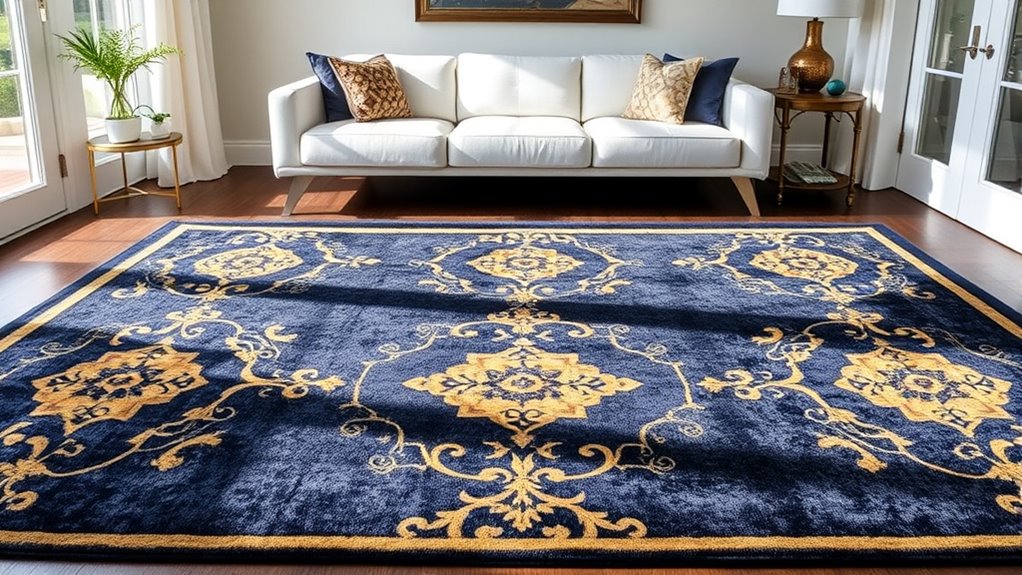
Choosing the right rug size is essential to creating a balanced and inviting space. When selecting area rugs, you want to consider how their size complements your furniture and room dimensions. A rug that’s too small can make your space feel disjointed, while a rug that’s too large might overwhelm the room. Focus on rug patterns that enhance your overall decor, ensuring they don’t clash or dominate the space. For a cohesive look, aim to have at least a few inches of flooring visible around the rug’s edges, especially under furniture. Remember, the goal is harmony—your rug should anchor the room without overpowering it. Picking the right size enhances the style and comfort of your space, tying everything together seamlessly. Additionally, space maximization techniques such as using multi-functional furniture and thoughtful placement can further improve the room’s overall flow and usability.
Measuring Your Room for Optimal Rug Placement
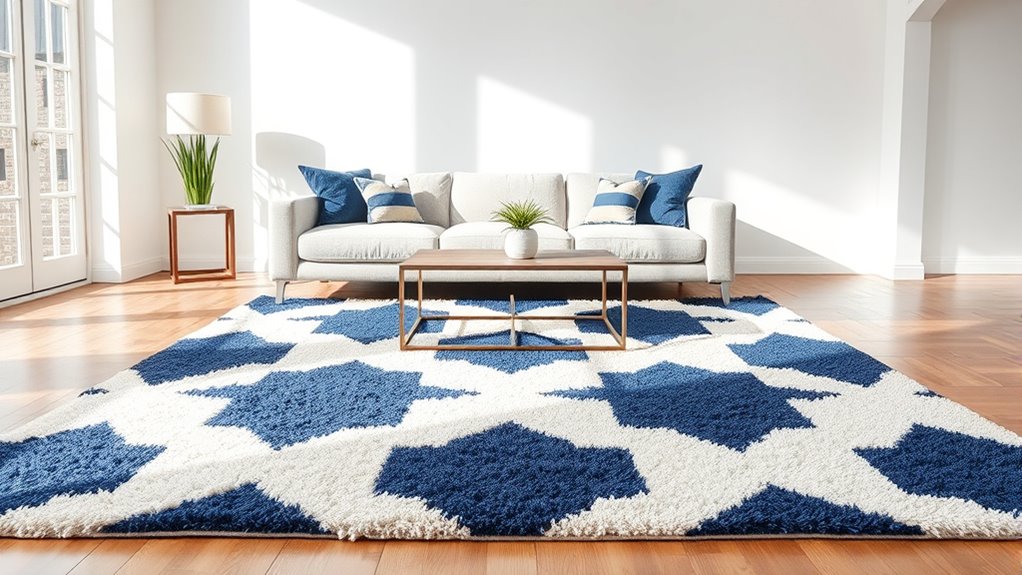
To guarantee your rug fits perfectly and enhances your space, start by accurately measuring your room. Use a tape measure to determine the length and width, noting down these dimensions. Consider the placement of furniture and how much floor space you want the area rugs to cover. Keep in mind that different rug textures can affect the room’s ambiance, so choose textures that complement your decor. For example, a plush rug texture adds warmth, while a flatweave offers a sleek look. Be precise with your measurements to avoid buying a rug that’s too small or large. Proper measurement ensures your statement rug becomes a balanced focal point, harmonizing with your furniture and overall room size. Additionally, selecting the right rug material can influence the room’s atmosphere and durability.
Placing Rugs in Living Rooms for Maximum Impact
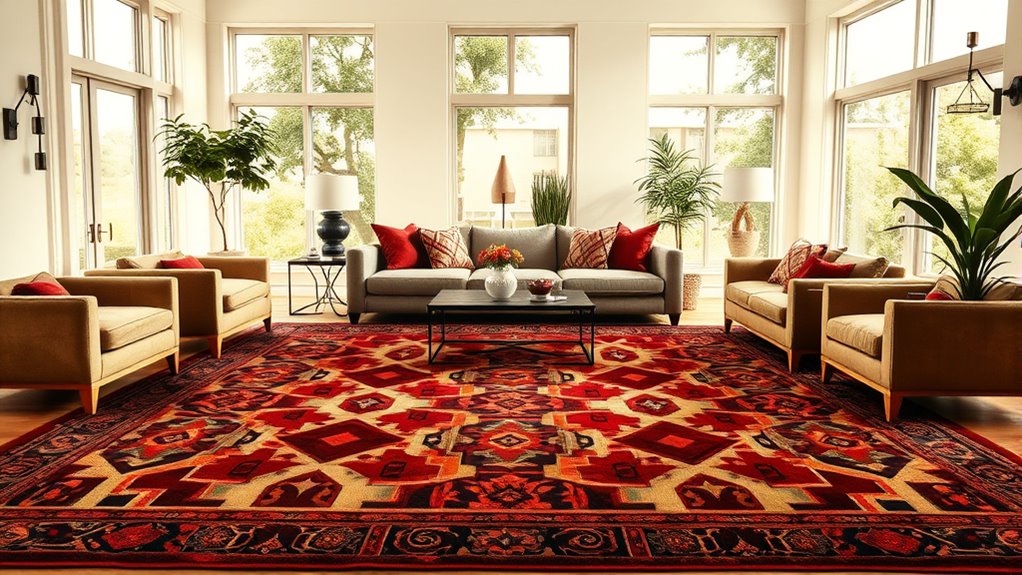
Placing a rug in your living room can instantly elevate the space, but strategic positioning is key to maximizing its impact. To create a balanced look, ensure your area rugs anchor the furniture. For example, you can:
- Place the front legs of sofas and chairs on the rug to unify seating areas.
- Use larger rugs that extend beyond all furniture legs for a cohesive feel.
- Consider rug materials like plush wool for comfort or natural jute for texture, depending on your style.
Position the rug so it frames the main seating area without overwhelming the room. Keep in mind that the right size and placement highlight your statement rug and tie the space together effortlessly. Selecting the appropriate rug size is essential for achieving a harmonious living room layout.
Defining Dining Areas With Statement Rugs
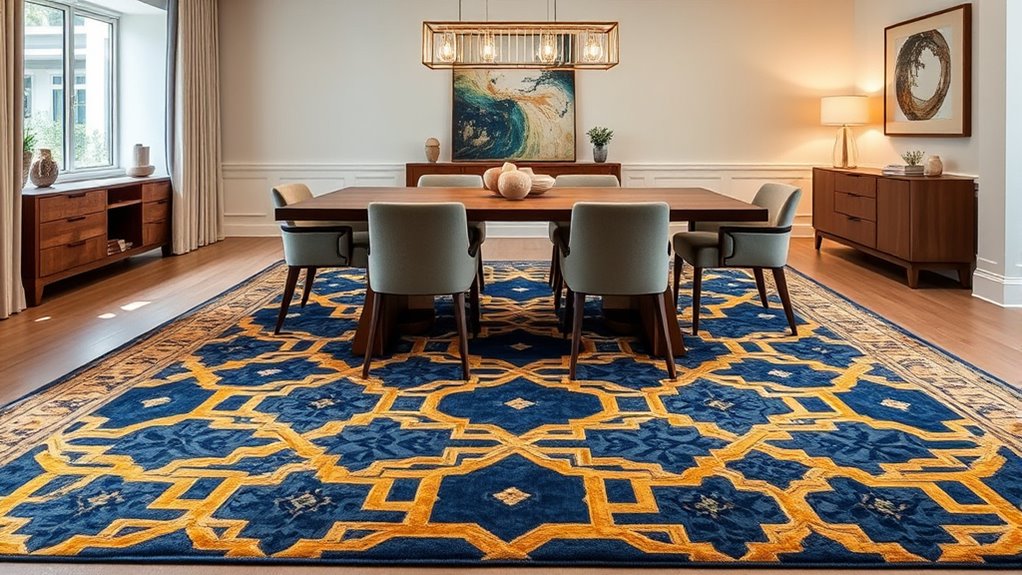
Choosing the right size rug is key to defining your dining space effectively. Proper placement guarantees the rug anchors the table without overwhelming the room. Keep these tips in mind to create a balanced and inviting dining area. Additionally, selecting weather-resistant materials ensures durability and longevity in your chosen space.
Rug Size Guidelines
When selecting a statement rug for your dining area, size is key to creating a balanced and inviting space. A good rule is to choose a rug large enough so that the chairs remain on it even when pulled out. Typically, you’ll want at least 24 inches of extra space around the table. Visualize a rug with plush, textured material that complements your decor, offering comfort and style. Remember, the rug material affects rug cleaning; opt for durable, stain-resistant options if you entertain often. Imagine a rug with:
- Substantial border extending beyond table edges
- Soft pile underfoot that withstands foot traffic
- Complementary colors that enhance your dining zone
- Incorporating consistent messaging can subtly reinforce your overall interior design theme
Choosing the right size ensures your statement rug anchors the space without overwhelming it, making your dining area both stylish and functional.
Proper Placement Tips
To effectively define your dining area with a statement rug, start by positioning the rug so that it clearly outlines the space without overwhelming it. Make certain the rug is large enough so that all dining chairs stay on it even when pulled out. For decor matching, choose a rug color that complements your existing table and chair hues, creating a cohesive look. Consider color coordination to make the space feel harmonious; bold patterns can add interest but should still blend seamlessly with your overall decor style. Center the rug beneath the table, leaving a border of at least 18-24 inches around the edges for visual balance. Proper placement ensures your statement rug enhances the area without cluttering or confusing the space. Additionally, understanding the size and placement rules can help you create a balanced and inviting dining area.
Positioning Rugs in Bedrooms for Comfort and Style
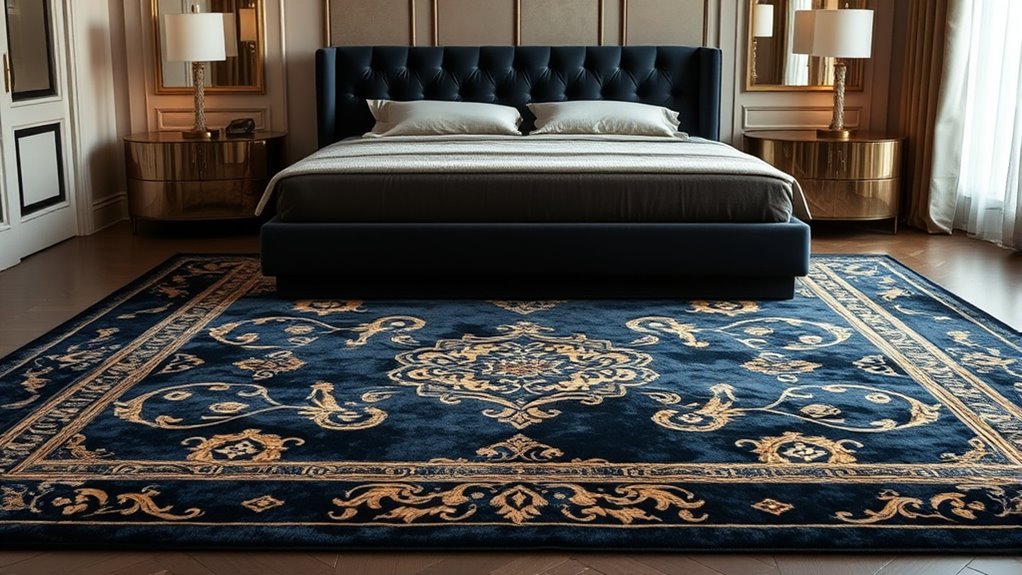
When placing a rug in your bedroom, consider how your bed’s position and the rug’s size work together to create balance and comfort. Make sure the rug edges are accessible and don’t obstruct walkways, so it feels functional and inviting. Layering multiple rugs can add texture and coziness, enhancing both style and relaxation in your space. Understanding symbolism in your decor choices can also help create a more meaningful and harmonious environment.
Bed Placement and Rug Size
Choosing the right bed placement and rug size can dramatically enhance both the comfort and style of your bedroom. To achieve this, consider how the rug interacts with your bed’s position. For example, a large rug under the entire bed creates a cozy, inviting feel, while a smaller rug at the foot adds a pop of color. Keep these in mind:
- Place the rug so it extends beyond the bed’s sides for balanced rug color coordination.
- Ensure it’s large enough to stay visible when you’re lying or sitting on the bed.
- Regular rug cleaning tips keep it fresh and vibrant, preventing stains and wear.
- Incorporating rustic decor elements can further enhance the farmhouse charm of your space.
Rug Edging and Accessibility
Proper rug edging and strategic placement can make a noticeable difference in both comfort and style within your bedroom. Well-finished rug edging prevents tripping hazards and ensures the rug stays securely in place, enhancing accessibility considerations. Choose a rug with reinforced edges or add binding to prevent fraying and create a clean look. When positioning your rug, ensure it extends beyond furniture edges to allow easy movement, especially around the bed. This not only improves safety but also adds to the room’s aesthetic appeal. If you have mobility challenges, opt for low-pile rugs with smooth edges to reduce tripping risks. Thoughtful rug edging and placement make your space more inviting and safer, balancing style with practical accessibility. Additionally, selecting rugs with durable materials can help maintain their appearance and safety over time.
Layering Rugs for Comfort
Layering rugs in your bedroom adds both comfort and style by creating visual interest and defining different areas. To achieve this, focus on texture blending and color coordination. Use a plush, textured rug beneath your bed to add warmth and softness, then layer a flat-woven or patterned rug nearby to introduce contrast and visual depth. This combination enhances the room’s coziness while making a design statement. For a cohesive look, select rugs with complementary colors or subtle patterns that tie the space together. Keep these key points in mind:
- Mix textures like shaggy and flat-weave for tactile interest
- Coordinate colors to match or subtly contrast your bedding and decor
- Ensure rug sizes layer seamlessly, with larger base rugs and smaller accent pieces
- Consider the impact of layering techniques on overall room design for a balanced aesthetic
This approach creates a layered, inviting bedroom environment.
Arranging Rugs in Open-Plan and Multi-Functional Spaces

Arranging rugs in open-plan and multi-functional spaces requires careful consideration to define distinct areas while maintaining a cohesive look. Start with your furniture arrangement; position pieces so that each zone has a clear purpose, and choose rugs that complement this layout. For example, place a large statement rug under the main seating area, anchoring the arrangement. Use color coordination to unify the space—select rugs that match or contrast intentionally with your furniture and decor. Avoid cluttering the space with too many small rugs; instead, opt for larger rugs that can delineate different zones without disrupting flow. Keep pathways clear and ensure that rug sizes are proportionate to furniture pieces. This approach creates a balanced, inviting environment that feels both connected and functional.
Tips for Layering and Overlapping Rugs
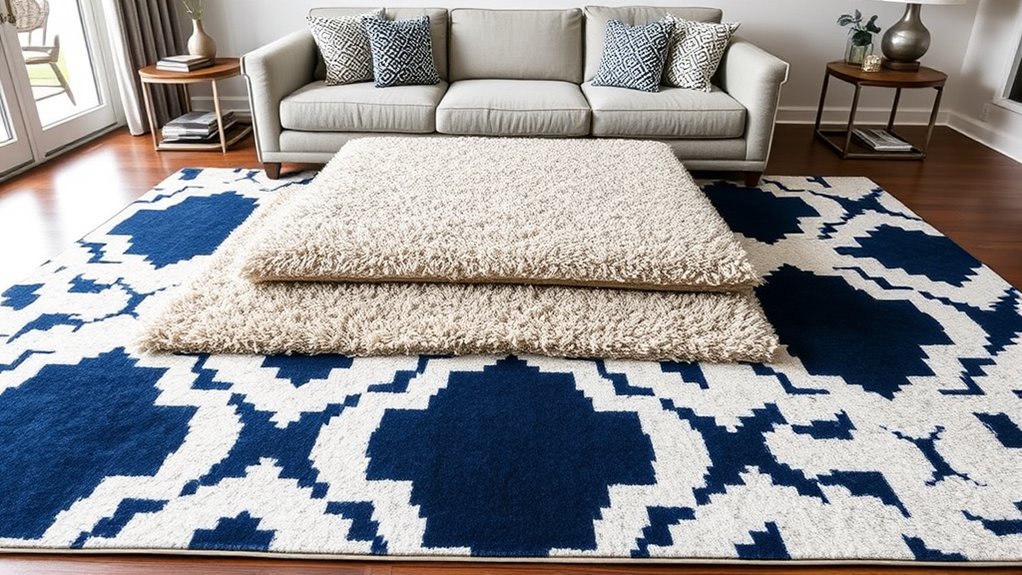
To create visual interest and define different areas within a space, you can effectively layer and overlap rugs. This technique adds depth and personality, especially when mixing textile textures and coordinating colors. When layering, consider varying textures—like a plush shag over a flat weave—to add tactile richness. Use color coordination to tie overlapping rugs together, creating harmony rather than chaos. For example:
- Place a patterned rug partially over a solid one, highlighting contrasting textures.
- Overlap smaller accent rugs with larger statement pieces to define zones.
- Combine different textile textures in overlapping rugs for a dynamic, inviting look.
Keep the overlapped edges casual or slightly uneven for a relaxed vibe, ensuring the overall effect feels intentional and stylish.
Maintaining Balance and Proportion With Rug Placement

When layering rugs, it’s important to maintain a sense of balance and proportion to guarantee the space feels harmonious. Start by ensuring the rugs complement each other through thoughtful color coordination. Avoid clashing by choosing hues that either match or create a pleasing contrast. Pattern mixing can add visual interest, but be cautious—combine patterns that vary in scale and style to prevent chaos. Keep the rug sizes proportional to the room’s dimensions; larger rugs anchor the space, while smaller ones add detail. Position rugs so they don’t overpower furniture or walls, maintaining a cohesive look. Balancing color, pattern, and size helps create a unified, stylish environment that feels intentional and inviting.
Frequently Asked Questions
How Do Different Rug Shapes Influence Room Aesthetics?
Different rug shapes can dramatically influence your room’s aesthetics. A rectangular rug with geometric patterns creates a structured, modern vibe, while a round rug softens sharp angles and adds visual interest. Asymmetrical designs in irregular-shaped rugs bring a dynamic, contemporary feel. You’ll find that choosing the right shape enhances your space’s balance and style, making it feel more cohesive and inviting. So, pick shapes that align with your room’s overall design.
What Are Common Mistakes to Avoid When Placing Statement Rugs?
Don’t let your eyes deceive you—placing a statement rug isn’t just about size. Avoid common rug size mistakes and placement errors that can throw off your room’s harmony. For example, a rug that’s too small can make the space feel disjointed, while placing it awkwardly can clash with furniture. Make certain your rug anchors the room and complements your layout, turning a potential misstep into a masterpiece.
How Can Rug Placement Enhance Room Acoustics?
You can enhance room acoustics by carefully placing your rug to improve sound absorption. Positioning a statement rug under key areas like seating or dining zones helps reduce echo and noise. Combining this with acoustic panels creates a balanced sound environment. Make sure the rug is large enough to cover high-traffic areas, which maximizes its sound absorption benefits and creates a more comfortable, quieter space.
Are There Specific Styles of Rugs Suited for High-Traffic Areas?
When choosing rugs for high-traffic areas, you should consider durability considerations and material selection. Opt for rugs made from sturdy materials like wool, nylon, or polypropylene, which withstand wear and tear. Styles such as low-pile or flatweave rugs are great because they resist crushing and are easier to clean. By selecting durable materials and appropriate styles, you guarantee your rug remains attractive and functional despite constant foot traffic.
How Do Seasonal Changes Affect the Choice and Placement of Statement Rugs?
Seasonal changes influence your choice and placement of statement rugs by prompting you to take into account seasonal decor and temperature considerations. In colder months, you might opt for thicker, plush rugs to add warmth, while lighter, breathable rugs suit warmer seasons. You should place rugs strategically to enhance seasonal decor and ensure they don’t trap heat or cold, helping you create a comfortable, stylish space year-round.
Conclusion
By mastering rug size and placement, you transform your space into a stunning sanctuary that leaves guests in awe. When you choose the right rug and position it thoughtfully, you create an ambiance so harmonious, it’s like your room breathes life. Remember, a well-placed statement rug isn’t just decor; it’s the heartbeat of your home. So, trust your instincts, and watch your space become an unforgettable masterpiece.









